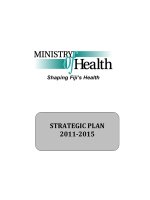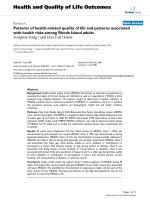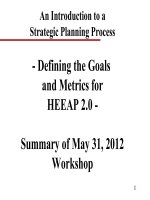Preconception Health 2013–2015 Rhode Island Strategic Plan docx
Bạn đang xem bản rút gọn của tài liệu. Xem và tải ngay bản đầy đủ của tài liệu tại đây (934.73 KB, 24 trang )
PRECONCEPTION HEALTH
2013–2015 Rhode Island Strategic Plan
Table of Contents
Background 2
Strategic Plan Development & Framework 10
Strategic Plan Recommendations 14
» Public Health 14
» Policy & Finance 15
» Healthcare & Health Promotion 16
» Consumers 17
Strategic Plan Implementation 18
Conclusion 18
Glossary 19
References 20
Acknowledgements
The Department of Health thanks its community partners who contributed their time and expertise to
developing this strategic plan.
This publication was made possible through funding from the Title V Maternal and Child Health Block Grant.
Citation
Rhode Island Department of Health. 2013–2015 Rhode Island Preconception Health Strategic Plan. September 2012.
Available at: www.health.ri.gov/publications/strategicplans/2013RhodeIslandPreconceptionHealth2015.pdf
PRECONCEPTION HEALTH
2013–2015 Rhode Island Strategic Plan
Dear Colleagues,
I am pleased to present you with the 2013–2015 Rhode Island Preconception Health Strategic Plan. This document provides
a detailed strategy to maximize healthy pregnancies and pregnancy outcomes in Rhode Island over the next three years.
Preconception care leads to better health and wellness for women, men, and families. It provides the opportunity for family
planning, which encourages the development of a reproductive life plan in line with an individual’s personal values and life
goals. As part of preventive care, preconception care identifies and mitigates health risk behaviors and chronic conditions
that may affect a potential pregnancy. Individuals who receive preconception care before and between pregnancies are
more likely to have healthy, planned pregnancies and less likely to have negative birth outcomes, such as low birth weight
babies and preterm birth.
According to 2009 Pregnancy Risk Assessment Monitoring System data, one in every three pregnancies in Rhode Island is
unintended. Unintended pregnancies may result in delayed access to prenatal care and a reduced opportunity for screening
and interventions for negative health behaviors, such as tobacco or alcohol use, that can lead to poor birth outcomes. High
rates of unintended pregnancy can lead to serious socioeconomic consequences and contribute to significant disparities in
reproductive health and pregnancy outcomes, particularly among young, poor, and minority women.
Implementing public health initiatives, comprehensive health policies, healthcare practices and promotion, and consumer
awareness to minimize disparities in preconception risk factors can help to reduce social, racial, and economic disparities
in health. No single agency, organization, or sector alone can improve preconception health. The Rhode Island Preconception
Health Strategic Plan is the result of a collaborative process involving the Rhode Island Department of Health (HEALTH)
and a large, diverse group of community partners that together form the Rhode Island Preconception Health Collaborative.
This Collaborative is committed to refining and carrying this plan through implementation to ultimately improve the health
of all Rhode Islanders.
We welcome your input to this statewide effort. To get involved, contact Tricia Washburn at
Sincerely,
Michael Fine, MD
Director of Health, Rhode Island Department of Health
PRECONCEPTION HEALTH :: 2013–2015 RHODE ISLAND STRATEGIC PLAN 1
2
Background
Introduction
Optimizing health and wellness before and between
pregnancies benefits individuals and their families by
improving health and pregnancy outcomes. Preconception
health, the health of an individual during prepregnancy
periods, encompasses a variety of strategies implemented
across a range of health and social service settings to
maximize healthy pregnancies. Many of the medical
conditions, personal behaviors, psychosocial risks, and
environmental exposures linked to negative pregnancy
outcomes (e.g., birth defects, low birth weight births, and
preterm births) can be identified and modified before
conception through preventive interventions.
1,2
Although
interventions tend to focus on women, these preconception
health opportunities are important to both women and men
across the life course, regardless of reproductive age or
pregnancy intention.
The life course perspective model is an important
component of preconception health. Providing a
continuum of care and preventive interventions across the
life course ensures that health is addressed at different life
stages as well as during critical and sensitive periods, such
as adolescence and the perinatal (around childbirth) and
postpartum periods. This approach improves not only the
future well-being of the individual but also the health of
future generations. Although genetics contributes both
protective and risk factors for disease, health reflects more
than genetics and personal choice. The life course
perspective model takes into account cumulative
protective and risk factors in several health domains—
physical, mental, environmental, economic, and spiritual
—in understanding patterns in health and disease.
Numerous intrapersonal, social, cultural, policy, and
environmental factors influence an individual’s health
throughout life.
3
Effective preconception health
interventions must therefore incorporate a broad spectrum
of strategies across the continuum of care to address the
range of influences on health outcomes. These strategies
can include clinical, public health, and public policy
solutions, all of which minimize disparities in
preconception risk factors (listed on page 13) and reduce
broader social, racial, and economic inequalities in health.
Health Disparities
Women in high-risk and low-income groups in particular
face barriers that prevent them from engaging in healthy
behaviors before pregnancy. These barriers may include a
lack of health insurance or education, the inability to take
time off work to visit a healthcare provider, or a lack of
access to healthy and affordable foods.
2
Racial differences in
the preconception health status of women are also
increasingly implicated as an important source of racial
disparities in reproductive health outcomes.
4
All of these
obstacles are compounded by the fact that in the United
States, the quality of primary care for numerous women of
childbearing age is inadequate, many uninsured women do
not receive care, and providers do not typically address
reproductive risks during primary care visits.
4,5
According to
2009–2010 Rhode Island Pregnancy Risk Assessment
Monitoring System (PRAMS) data, 16% of women reported
being uninsured the month before they became pregnant.
5
Adolescents often encounter additional barriers that
contribute to their high risk for unintended pregnancy and
negative health behaviors before pregnancy. Many teens
do not regularly access preventive care. In 2010 in the
United States, the aggregate percent of adolescents
enrolled in Medicaid and private health plans who received
a preventive care visit was 64%.
6
Increasing adolescent
access to preventive care, including preconception care, is
important to encourage healthy behaviors and address
sexual health early in life.
In Rhode Island, the lack of an explicit law defining minor
consent and confidentiality parameters limits adolescent
access to reproductive health services, including
contraception.
7
In 2009 among Rhode Island high school
students reporting that they ever had sexual intercourse,
12% did not use any contraceptive method the last time
they had sex.
8
From 2005 through 2009, Rhode Island’s
teen pregnancy rate for ages 15–19 was nearly 1 in 20,
placing added pressure on these adolescents, their
families, and society.
9
Adverse outcomes associated with
teen births include health risks for mother and child,
individual and familial poverty, and reduced educational
attainment. Public sector costs associated with teen
childbearing in Rhode Island were estimated at nearly $49
million in 2008.
10
Additional socioeconomic and health
pressures result from repeat births among teens; Rhode
Island’s repeat birth rate for teens ages 15–19 was 17.6%
from 2006 through 2010.
11
PRECONCEPTION HEALTH :: 2013–2015 RHODE ISLAND STRATEGIC PLAN 3
Effective preconception health interventions must incorporate a
broad spectrum of strategies to address the range of influences on
health outcomes. These strategies can include clinical, public health,
and public policy solutions, all of which minimize disparities in
preconception risk factors and reduce broader social, racial, and
economic inequalities in health.
4
Clinical Interventions
In the clinical setting, preconception care can be routinely
integrated not only into visits related to reproductive
health but into all healthcare visits before conception,
regardless of pregnancy intention. Every primary care
encounter offers an opportunity for clinicians to address
preconception health and engage in relevant risk
screening, referral, and education. Discussing preconception
health creates an opening for dialogue about a patient’s
readiness for pregnancy, his or her health status, and the
impact of social, environmental, occupational, behavioral,
and genetic factors on a future pregnancy. It also offers an
opportunity to identify individuals at risk for adverse
pregnancy outcomes and to provide contraceptive
counseling to those not intending to become pregnant.
Development of a reproductive life plan between a
provider and patient in the clinical setting encourages
family planning, including consideration of healthy birth
spacing of at least 18 months between a previous birth
and conception of a subsequent birth.
14
A reproductive life
plan outlines an individual’s pregnancy intention and
preferred number, spacing, and timing of children while
taking into account his or her personal values, life goals,
and reproductive age. It can help an individual decide on
next steps to either prevent or plan for a pregnancy.
Figure 1
Unintended Pregnancy: Demographic Characteristics, Rhode Island, 2004–2008
Source: Rhode Island Department of Health. Rhode Island Pregnancy Risk Assessment Monitoring System 2012 Data Book.
100%
90%
80%
70%
60%
50%
40%
30%
20%
10%
0%
Statewide <20 20–29 ≥30 White Black Other Yes No <12 12 >12 Married Unmarried Public Private Yes No
Age Race Hispanic Ethnicity* Education Years* Marital Status Health Insurance WIC Participation*
* Statistically significant difference at p-value < 0.001 Healthy People 2010 goal
Women with an unintended pregnancy are more likely to engage in negative health behaviors, including delaying
prenatal care, using tobacco and alcohol during pregnancy, and not breastfeeding their infants, all of which can
cause adverse effects for both mothers and infants.
12
As shown in Figure 1, some Rhode Island women are more
likely to have an unintended pregnancy than others. From 2004 through 2008, mothers who were younger than
20 years old (75.0%), black (54.9%), Hispanic (46.0%), had less than 12 years of education (58.2%), were unmarried
(60.1%), had public health insurance (54.7%), and/or participated in the WIC program (54.8%) had a higher
prevalence of unintended pregnancy than other women.
30.0
38.6
75.0
36.0
58.2
46.0
24.1
54.7
25.9
44.5
54.9
47.7
37.6
60.1
25.1
54.8
24.5
46.1
27.3
PRECONCEPTION HEALTH :: 2013–2015 RHODE ISLAND STRATEGIC PLAN 5
Figure 2
Prenatal Care in First Trimester: Demographic Characteristics, Rhode Island, 2004–2008
Source: Rhode Island Department of Health. Rhode Island Pregnancy Risk Assessment Monitoring System 2012 Data Book.
100%
90%
80%
70%
60%
50%
40%
30%
20%
10%
0%
Statewide <20 20–29 ≥30 White Black Other Yes No <12 12 >12 Married Unmarried Public Private Yes No
Age Race Hispanic Ethnicity* Education Years* Marital Status Health Insurance WIC Participation*
* Statistically significant difference at p-value < 0.001 Healthy People 2010 goal
Early prenatal care provides opportunities for detection, treatment, and management of medical and
obstetric conditions, as well as the opportunity to encourage healthy behaviors by educating women during
pregnancy.
13
As shown in Figure 2, Rhode Island mothers who were age 30 or older (89.6%), white (86.7%),
non-Hispanic (86.6%), had more than 12 years of education (91.8%), were married (90.5%), had private health
insurance (91.7%), and/or did not participate in the WIC program (90.5%) had a higher prevalence of initiating
prenatal care in the first trimester than other women.
90.0
84.8
68.0
86.7
70.7
75.9
90.5
77.8
90.5
83.6
78.1
81.1
86.6
76.3
91.7
77.7
89.6
73.3
91.8
Reproductive life plans are ongoing and should be
re-evaluated throughout the life course as an individual’s
goals evolve.
15
Impact of Unintended Pregnancy
A planned pregnancy provides an opportunity for women
to improve their health by addressing risk factors and
behaviors before conception. Women who plan their
pregnancies are less likely to have clinical complications
during pregnancy and more likely to have better birth
outcomes. Yet in 2009, approximately 37.3% of
pregnancies in Rhode Island were unintended (mistimed or
unwanted).
9
From 2006 through 2010, 18% of Rhode
Island births were conceived 12 months or less from a
previous live birth, which increases the risk for maternal
morbidity and mortality, preterm birth, low birth weight,
and small-for-gestational-age infants.
11
Data from the national and Rhode Island PRAMS surveys
confirm that many women do not engage in healthy
behaviors before becoming pregnant.
4,16
Among Rhode
Island mothers from 2004 through 2008, 20.4% were
obese prior to pregnancy and 65.3% did not take a daily
multivitamin prior to pregnancy (Figure 3). Among Rhode
Island women who did not want to become pregnant,
53.6% did not use birth control at the time of pregnancy.
5
Figure 4 illustrates that Rhode Island mothers who had an
6
unintended pregnancy were also significantly more likely
than women with a planned pregnancy to report that
they:
• Didnottakemultivitaminsdailypriortopregnancy
(80.6% vs. 55.5%).
• Experiencedintimatepartnerviolenceduringthe12
months before or during pregnancy (9.0% vs. 3.6%).
• Haddelayedornoprenatalcare(24.5%vs.9.3%).
• Smokedduringpregnancy(17.1%vs.8.6%).
• Hadalowbirthweightbaby(7.5%vs.7.0%).
• Neverbreastfedtheirbaby(31.6%vs.23.6%).
5
These data emphasize the need for the routine provision
of preconception care to all individuals of reproductive
age, regardless of pregnancy intention.
15,17,18
Coordinated Care
To ensure comprehensive, effective, and sustainable
promotion of preconception health, greater cooperation
and coordination is needed across health and social service
specialties and sectors. Linking different service delivery
systems and integrating preconception health promotion
and care elements within them will improve and
streamline access to preconception services. It will also
help reduce potential gaps or missed opportunities to
provide these services.
2,4
Pregnancy testing, for instance, is
often an initial point of access to the healthcare system.
These visits can serve as an opportunity to address
preconception health or to link women to early prenatal
care, insurance, and social services. For some individuals,
access to medical care is challenging because of financial
constraints, lack of insurance, transportation issues, time
limitations, or other competing priorities. For these
individuals, it is important to identify additional
opportunities and settings to address preconception
health, such as through social and educational services.
2
Figure 3
Select Pregnancy Risks,
Rhode Island, 2004–2008
Source: Rhode Island Department of Health. Rhode Island
Pregnancy Risk Assessment Monitoring System 2012 Data Book.
100%
90%
80%
70%
60%
50%
40%
30%
20%
10%
0%
Did not take a Obese prior to Experienced intimate
daily multivitamin pregnancy partner violence
prior to pregnancy before or during
pregnancy
Figure 4
Pregnancy Risks and Outcomes by Pregnancy
Intention, Rhode Island, 2004–2008
Source: Rhode Island Department of Health. Rhode Island Pregnancy Risk Assessment
Monitoring System 2012 Data Book.
100%
90%
80%
70%
60%
50%
40%
30%
20%
10%
0%
No Daily Intimate Delayed / Tobacco Low Birth Never
Vitamin** Partner No Prenatal Use** Weight* Breastfed**
Violence Care**
* Statistically significant difference at p-value < 0.05
** Statistically significant difference at p-value < 0.001
65.3
80.6
9.0
24.5
17.1
7.5
31.6
55.5
3.6
9.3
8.6
7.0
23.6
20.4
5.7
n Unintended Pregnancy
n Intended Pregnancy
PRECONCEPTION HEALTH :: 2013–2015 RHODE ISLAND STRATEGIC PLAN 7
National Response
In 2006, the United States Department of Health and
Human Services, Centers for Disease Control and Prevention
(CDC) responded to the growing body of evidence
connecting preconception interventions to improved health
and pregnancy outcomes by releasing its Recommendations
to Improve Preconception Health and Health Care. These
recommendations seek to improve the health of women
and couples both before and between pregnancies by
improving preconception health and healthcare.
1,17
The 10 CDC recommendations center on individual
responsibility across the life course, consumer awareness,
preventive visits, interventions for identified risks,
interconception care, prepregnancy checkups, health
insurance coverage for women with low incomes, public
health programs and strategies, research, and monitoring
improvements.
The CDC identifies four goals to improve preconception
health:
• Improvetheknowledge,attitudes,andbehaviorsof
men and women related to preconception health.
• Assurethatallwomenofchildbearingagereceive
preconception care services that will enable them to
enter pregnancy in optimal health.
• Reducerisksassociatedwithapreviouspoorbirth
outcome.
• Reducedisparitiesinadversepregnancyoutcomes.
A number of other national initiatives and guidelines
complement the CDC recommendations. Healthy People
2020 reinforces the importance of preconception health
by consolidating several of its health indicators under the
category “Preconception Health and Behaviors”.
19
The
Institute of Medicine (IOM) recommends providing
preconception care during well-woman preventive visits,
including evidence-based tests, procedures, and screenings
for nonpregnant women to prevent and treat their chronic
conditions and enhance their reproductive outcomes. The
provision of appropriate education and counseling during
preventive care visits is also recommended to decrease
unintended pregnancy and promote healthy birth spacing.
The IOM further advises that clinicians offer women
a full range of Food and Drug Administration-approved
contraceptive methods and sterilization procedures.
20
The Patient Protection and Affordable Care Act promises
to increase access to these clinical preventive services by
reducing cost as a barrier.
17
Other states have also
developed initiatives and implemented strategies to address
preconception health through capacity building, resource
development, and optimization of partnerships.
21–25
To ensure comprehensive, effective, and sustainable promotion
of preconception health, greater cooperation and coordination
is needed across health and social service specialties and sectors.
8
FORMATIVE RESEARCH SUMMARY
The Rhode Island Department of Health conducted formative research with key informants
and consumers to assess the current provision of reproductive health services in Rhode Island
and identify relevant resource and referral needs. Many questions focused on provider training
and strategies to discuss pregnancy intention, preconception care, and pregnancy prevention.
The resulting research report summarized gaps and opportunities in perceptions, practices, and
resources related to preconception health in Rhode Island. An excerpt of the key findings follows.
Perceptions
Most providers were unfamiliar with discussing sexual
and reproductive health in terms of pregnancy
intention and preconception care and had not been
taught to formally or routinely address these topics
with patients. Instead, when these topics are addressed,
provider discussion is generally focused on pregnancy
prevention and contraception. Most providers
consistently address a number of the preconception
health domains (see page 13) with patients and focus
group participants find these conversations helpful.
Provider training to discuss these topics, however, is
not typically framed in terms of preconception care.
Nearly all key informants agreed that it is important
to consistently discuss pregnancy intention,
preconception care, and pregnancy prevention with
patients and to consistently train students and
residents to address these topics.
Practice
Almost all providers said that they feel comfortable
discussing pregnancy intention, preconception
care, and pregnancy prevention with patients, but
only a handful reported having these conversations
at all points of contact. Most providers have
these conversations primarily during annual and
reproductive health visits and primarily with female
patients. Providers are also more likely to have a
conversation about preconception care or pregnancy
prevention than about pregnancy intention.
Effective strategies that providers reported for
talking about pregnancy intention, preconception
care, and pregnancy prevention focused on
direct, nonjudgmental, and routine conversation
to normalize discussion and make the patient
comfortable. Providers emphasized the importance
of both creating an opening for patients to start
the conversation and framing discussion in terms of
patient life plans and goals. Those providers who
do discuss pregnancy intention, preconception care,
and pregnancy prevention broach these topics using
a variety of approaches. Many of them lead with a
question about pregnancy and spin the question in
a way that helps patients clarify their feelings. (See
“Sample Pregnancy Intention Questions” on the
following page.)
Many providers mentioned patient ambivalence
as a major barrier to effectively discussing these
topics with a variety of patients. Key informants
and focus group participants also identified age,
gender, culture, language, sexual orientation,
and socioeconomics as barriers that may prevent
providers from effectively connecting with patients
about pregnancy intention, preconception care,
and pregnancy prevention. Quite a few providers
expressed concerns about confidentiality in
discussing and providing services on these topics
with patients, particularly with teens, and many
providers identified confidentiality as an important
PRECONCEPTION HEALTH :: 2013–2015 RHODE ISLAND STRATEGIC PLAN 9
training topic and resource need. Many informants
further acknowledged that a provider bias against
teen pregnancy interferes with discussing pregnancy
intention with teens, even when those discussions
should take place. Although a number of providers
reported that having a parent in the room poses a
barrier to discussing reproductive health with teens,
others feel comfortable either having parents present
for the discussion or asking them to step out.
Most focus group participants reported having good
relationships with and feeling comfortable talking
to their primary care providers. Many suggested
that they would be comfortable talking to their
providers about sensitive topics such as emergency
contraception, unsafe relationships, and reproductive
coercion, although few reported that their providers
address these topics. Conversely, participants
reported that they were not comfortable talking
about unplanned pregnancy with their providers,
although providers did address this topic with them.
Most participants reported that their providers did
not talk to them about reproductive health, sexual
health, or family planning when they were teens
and that they did not feel comfortable having those
conversations with their providers as teens, but they
acknowledged the importance of these conversations
taking place.
Resources
A number of providers suggested that they would
benefit from additional training on pregnancy
intention, preconception care, and pregnancy
prevention. Many had received relevant training
only informally and in the clinical setting. Providers
suggested that the lack of a formal curriculum
highlights the need for a more structured approach
to addressing these topics with students and
residents. They emphasized the importance of
learning specific strategies to talk to patients
about these topics and found experiential learning,
primarily through clinical exposure, to be a
particularly effective teaching strategy. A number
of providers were also receptive to framing the
discussion of pregnancy intention, preconception
care, and pregnancy prevention in alternate ways.
Key informants brought up a number of policies that
influence the ability of providers to effectively address
pregnancy intention, preconception care, and pregnancy
prevention with patients. These include policies around
insurance reimbursement, confidentiality, and other
practice guidelines and protocols. Many key informants
also mentioned needing more time, funding, staff, and
other specific resources to more effectively address the
three key topics with patients.
The full research report is posted at www.health.ri.gov/publications/reports/2012PreconceptionHealthFormativeResearch.pdf
Sample Pregnancy Intention Questions
Many providers who discuss pregnancy intention, preconception care,
and pregnancy prevention lead with a question that helps patients
clarify their feelings about becoming pregnant.
Do you intend to become pregnant over the next year?
26
Are you planning on becoming pregnant?
If you did get pregnant right now, how would you feel?
Have you thought about another baby being part of your life?
10
Strategic Plan Development & Framework
Strategic Plan Development
Building on national opportunities, resources, and previous
Department initiatives to address women’s health, the
Rhode Island Department of Health (HEALTH) embarked
on developing a strategic plan to identify and prioritize the
preconception health needs of Rhode Island. Through
funding made possible by the federal Title V Maternal and
Child Health Block Grant, HEALTH’s Division of
Community, Family Health, and Equity coordinated this
statewide effort. As HEALTH has no specific program
dedicated to preconception health, staff working in related
programs facilitated the process with the support of an
external health and human services consultant.
To initially inform strategic plan development, HEALTH
conducted formative research with Rhode Island healthcare
professionals and consumers. HEALTH first interviewed 50
key informants in the primary care, medical education, and
health insurance communities to assess the current provision
of reproductive health services and identify relevant
resource and referral needs. HEALTH then conducted focus
groups with English- and Spanish-speaking women to
learn about consumer attitudes toward, access to, and use
of reproductive health services. Focus group participation
was extremely limited, but participant input reinforced and
supplemented key informant interview findings.
The resulting research report summarized gaps and
opportunities in perceptions, practices, and resources
related to preconception health in Rhode Island (see
“Formative Research Summary” on pages 8 and 9). HEALTH
used these findings, along with relevant national resources
PRECONCEPTION HEALTH :: 2013–2015 RHODE ISLAND STRATEGIC PLAN 11
and preconception health plans and approaches from other
states, to draft a preliminary framework and recommendations
for a preconception health strategic plan. This draft
provided a well-defined starting point to further identify
and refine statewide preconception health priorities.
Building on existing community partnerships, HEALTH
invited a wide range of stakeholders to collaborate in the
statewide strategic planning process to both ensure the
development of a comprehensive strategic plan and build
coordinated systems of care. In addition to inviting the key
informant participants, HEALTH elicited partnership
suggestions from an internal team whose work addresses
maternal and child health. Criteria for professional
stakeholder suggestions included partners in relevant
disciplines with a potential interest in preconception health
who could also contribute their expertise to strategic plan
development and implementation. HEALTH also invited
consumer input through a variety of partner organizations.
After vetting the preliminary framework and recommendations
with internal stakeholders, HEALTH sent the research report,
the draft, and an invitation to participate in a series of
statewide strategic planning sessions to all prospective partners.
During these well-attended sessions, a facilitator consultant
elicited feedback on the draft content and language and
encouraged participants to identify additional plan gaps and
opportunities. During each session, participants discussed and
refined edits from the previous session to ensure the accurate
integration of stakeholder input. HEALTH initially scheduled
two two-hour strategic planning sessions but later added a
third session to ensure that adequate time was available to
discuss the entire draft. After the last session and prior to
finalizing the document, HEALTH vetted the revised framework
and recommendations by email with partners who were either
present at or unable to attend the strategic planning sessions.
Strategic Plan Framework
The Rhode Island Preconception Health Strategic Plan
resulting from this collaborative effort lays out a broad and
inclusive conceptual Framework rooted in targeted and
achievable Recommendations and Strategies. The
Framework recognizes that all individuals across the life
course—younger than and beyond their reproductive
years, not yet pregnant and between pregnancies, of
various sexual orientations—are touched by preconception
health. The Strategic Plan Recommendations and
Strategies, on the other hand, focus on individuals of
reproductive age.
The Preconception Health Strategic Plan Framework,
which includes a vision and mission, performance
measures, key definitions, and guiding principles, is
summarized on pages 12 and 13. The three-year strategic
plan timeframe, from 2013 through 2015, allows for
stakeholders to revisit the plan and address emerging
needs after full implementation of the federal Patient
Protection and Affordable Care Act in early 2014.
The Strategic Plan Recommendations fall into four topic
areas: Public Health, Policy and Finance, Healthcare and
Health Promotion, and Consumers. These Recommendations
and the Strategies to achieve them are outlined in detail in
the next section. A few Strategies will be led by a
community coalition or collaborative actively focused on
that issue. Some Strategies also include Sample Activities
to clarify their purpose. These Sample Activities and
additional action steps will be further developed during
the Strategic Plan implementation phase described at the
end of this document.
The Rhode Island Preconception Health Strategic Plan, resulting
from a collaborative effort with community partners, lays out a
broad and inclusive conceptual Framework rooted in targeted and
achievable Recommendations and Strategies.
12
STRATEGIC PLAN FRAMEWORK
Timeframe: 2013–2015
Vision: Enhance the health of all Rhode Islanders to
maximize healthy pregnancies and pregnancy outcomes.
Mission: Preconception health will be systematically
addressed through implementation of public health
initiatives, comprehensive health policies, healthcare
practices and promotion, and consumer awareness in
Rhode Island.
Performance Measures
The preconception health indicators listed below are
state-level markers of preconception health measurable by
HEALTH through existing internal data sources. A list of
preconception health domains that may be assessed
during a provider visit and that will be monitored in
partnership with other HEALTH programs and community
partners is included on the following page.
1. Increase the proportion of individuals who receive
preconception care services.
Measured through the Rhode Island Pregnancy Risk
Assessment Monitoring System (PRAMS)
2. Decrease the proportion of unintended pregnancy.
Measured through the Rhode Island Pregnancy Risk
Assessment Monitoring System (PRAMS)
3. Reduce the proportion of pregnancies conceived
within 18 months of a previous live birth.
Measured through the Rhode Island Department of
Health Maternal and Child Health Database
Definitions
Preconception Health: The health and wellness of all
individuals across the life course that results in optimal
pregnancy outcomes.
Preconception Care: Health prevention and management
interventions that aim to identify and modify individual
biomedical, behavioral, and social risks affecting
pregnancy outcomes. Preconception care encompasses the
discussion of pregnancy intention, pregnancy prevention,
and reproductive life planning.
Guiding Principles
The following concepts cut across all strategic plan
Recommendations and Strategies:
• Relevanttobothfemalesandmalesacrossthe
life course
• Routinelyimplementedacrossthelifecourse
• Includesphysical,mental,behavioral,and
environmental risk factors that impact health
• Incorporatescomprehensive,continuous,and
coordinated care
• Respectsdiversitywithinthecontextofindividual,
family, community, and cultural values
• Promoteshealthequity,andaddressessocialand
environmental determinants of health and health
disparities
• Promotesreproductivejustice,whichexistswhenall
individuals have economic and social power and
resources to make healthy decisions about their
bodies, sexuality, and reproduction
• Valuesthevoiceofthecommunityandconsumers
Preconception Health Domains and Risk/Protective Factors
General Health Status and Life Satisfaction
» Self-rated health
Social Determinants of Health
» Education
» Poverty
» Housing
Healthcare
» Access to and use of healthcare
» Access to dental care
» Access to reproductive healthcare
» Content and quality of care
» Immunizations
Reproductive Health and Family Planning
» Previous preterm birth
» Previous fetal death, miscarriage, or stillbirth
» Interpregnancy interval/birth spacing
» Pregnancy intention
» Contraception (access, availability, and use)
» Use of assisted reproductive technology
Tobacco, Alcohol, and Substance Abuse
» Smoking
» Alcohol consumption
» Secondhand smoke exposure
» Prescription medications
» Illicit/street drugs
Environmental Exposure
» Household chemicals
» Lead
» Other environmental and/or
occupational exposures
Nutrition and Physical Activity
» Fruit and vegetable consumption
» Appropriate weight gain
» Overweight and obesity
» Folic acid supplementation
» Breastfeeding
» Exercise/physical activity
Mental Health
» General mental distress
» Anxiety and depression
» Postpartum anxiety and depression
» Emotional and social support
» Intimate partner violence (physical and mental)
» Adequacy of support
Chronic Conditions
» Diabetes
» Hypertension
» Asthma
» Other chronic conditions
Infections
» HIV
» HPV
» Other sexually transmitted infections
» Other infections
Genetics and Epigenetics
» Family history
» Genetic screenings
Adapted from Broussard DL, Sappenfield WB, Fussman C, Kroelinger CD, Grigorescu V. Centers for Disease Control
and Prevention/Council of State and Territorial Epidemiologists, Atlanta, GA. Maternal Child Health J. February 2011;
15(2):158–168.
PRECONCEPTION HEALTH :: 2013–2015 RHODE ISLAND STRATEGIC PLAN 13
14
Strategic Plan Recommendations
PuBLiC HeALTH
Recommendation 1: Integrate components of preconception health into relevant public health and
community programs.
PARTNERSHIPS
Strategy
Community Partnerships: Establish and maintain
partnerships to facilitate the integration of preconception
health into existing public health and community
programs.
RESOURCES
Strategy
State Contract Modification: Modify state contracts to
integrate components of preconception health.
Sample Activities
» Assess contracted agencies’ provision of
preconception care services.
» Promote core competencies of contracted
agency staff to include preconception health.
PuBLiC HeALTH
Recommendation 2: Maximize data collection and sharing to monitor and evaluate preconception
health-related activities and outcomes.
RESOURCES
Strategy
Public Health Data: Use data to inform preconception
health program and policy decision making.
Sample Activities
» Define data needs related to preconception health.
» Identify available preconception health data sources.
» Identify new preconception health data sources.
» Identify opportunities to coordinate and share
preconception health data.
QUALITY IMPROVEMENT
Strategy
Quality Improvement Data: Encourage providers,
insurers, state agencies, and the health insurance
exchange to integrate preconception health measures into
their service delivery systems as part of quality
improvement initiatives.
Sample Activities
» Identify current preconception health quality
improvement measures implemented in service
delivery systems.
» Evaluate these preconception health quality
improvement measures in terms of outcomes.
» Provide information/education about how to capture
and measure data for quality improvement.
» Promote educational opportunities for data mining.
POLiCY & FiNANCe
Recommendation: Expand the affordability of and access to preconception care for all individuals of
reproductive age.
LEGISLATIVE ADVOCACY
Strategies
Patient Confidentiality Laws: Explore the feasibility of
advocating for changes in Rhode Island adolescent patient
confidentiality laws.
Minor Consent to Care Laws: Explore the feasibility of
advocating for changes in Rhode Island minor consent to
care laws.
Medicaid Family Planning Expansion: Advocate for the
expansion of Medicaid coverage for family planning
benefits to serve all income-eligible individuals.
HEALTHCARE REFORM ADVOCACY
Strategies
Health Insurance Exchange Contraception
Integration: Advocate for contraception to be included
in the state’s health insurance exchange as a covered
preventive service.
Health Insurance Exchange Preconception Care
Integration: Advocate for preconception care to be
included in the state’s health insurance exchange as a
covered preventive service.
Postpartum Visit Guidelines: Advocate for changing
postpartum visit guidelines from 6 weeks to 3–4 weeks.
Source: Rhode Island Task Force on Premature Birth,
Recommendation I: Increase Inter-Pregnancy Interval.
INSURANCE ADVOCACY
Strategies
Postpartum Contraception Reimbursement: Advocate
for adequate and appropriate reimbursement of
contraceptive methods during the postpartum period.
Healthcare Site Contraception Dispensation: Explore
the feasibility of advocating for insurers to reimburse
healthcare sites for dispensing contraceptives.
Medicaid Extended Family Planning Benefits
Promotion: Advocate for enhanced consumer and
provider outreach communication about Medicaid
extended family planning benefits to define eligibility,
covered services, and access to care.
Sample Activities
» Identify the agencies that develop and distribute
outreach materials.
» Ensure that materials are compliant with national
standards for Culturally and Linguistically Appropriate
Services (CLAS).
» Ensure that outreach communication materials are
distributed widely to anyone working with families.
» Develop additional communication strategies to
address literacy issues.
» Explore having healthcare providers who serve children
and adolescents inform parents of benefits.
Preconception Care Codes: Advocate for providers and
insurers to use universal preconception care codes for
adequate reimbursement.
Sample Activities
» Identify preconception care coding reimbursement
practices among insurers.
» Identify current provider practices around coding for
preconception care services.
» Develop universal preconception care codes for providers.
» Educate providers on using reimbursable preconception
care codes.
» Implement continuous quality improvement for
preconception care code use at the state and
practice levels.
PRECONCEPTION HEALTH :: 2013–2015 RHODE ISLAND STRATEGIC PLAN 15
16
HeALTHCAre & HeALTH PrOMOTiON
Recommendation: Promote and support the discussion of preconception health by healthcare providers
and allied professionals for all individuals of reproductive age.
ADVOCACY
Strategies
Professional Guidelines: Advocate for the revision and/
or expansion of existing healthcare professional and allied
professional guidelines to incorporate recommendations
specific to preconception health.
Sample Activities
» Research existing guidelines.
» Compile evidence-based recommendations.
» Partner with local chapters of professional
organizations to advocate for revision and/or
expansion of national guidelines.
Educational Curricula Integration: Advocate for
colleges and universities to incorporate preconception
health into undergraduate, graduate, and postgraduate
curricula for healthcare providers and allied professionals.
Patient Confidentiality Policies: Encourage clinical
providers and practices to develop guiding principles and/
or policies that address the need for adolescent patient
confidentiality.
EMR Triggers: Advocate for the integration of
preconception health triggers into Electronic Medical
Record (EMR) systems.
Sample Activities
» Identify relevant existing EMR templates.
» Develop model EMR templates.
» Promote adoption of model EMR templates.
» Research funding opportunities for EMR development
and implementation.
School-Based Education: Advocate for strengthening
school-based comprehensive sexuality and family life
education in schools. Source: The Rhode Island Alliance,
Changing the Lens: A Reframed Approach to Preventing
Teen Pregnancy, January 2012, Objective 5: Strengthen
School-Based Sexuality and Family Life Education.
RESOURCES
Strategies
Interdisciplinary Research: Foster interdisciplinary
research related to preconception health.
Professional Toolkit: Compile and promote a healthcare
provider and allied professional toolkit.
Sample Toolkit Contents
» Tools and strategies to accurately and openly discuss
preconception health, including sexual activity,
pregnancy intention, pregnancy prevention,
reproductive life planning, and health risk screening
and intervention (e.g., One Key Question, CDC
Reproductive Life Planning Tool, health risk screening
tool, health risk screening framing guidelines,
discussion timing guidelines)
» Tools and strategies for discussing preconception
health with specific populations (e.g., adolescents)
» Professional guidelines specific to preconception health
» Guidelines on integrating basic family planning and
birth spacing counseling into prenatal care
» Federal and state confidentiality resources
» State referral resources for contraceptive services for
adolescents
» State referral resources linking patients to proven
interventions
» EMR template with preconception health triggers
Sample Activities
» Identify and/or develop toolkit materials.
» Collaborate with community groups that provide
referrals.
» Research existing models that are successfully working
with providers.
» Explore inclusion of environmental indicators in health
risk screening tool.
» Develop a comprehensive website that serves as a
clearinghouse for preconception health information
and a networking source for healthcare providers and
allied professionals.
EDUCATION
Strategies
Professional Education Development: Develop
professional education opportunities for healthcare
providers and allied professionals on key topics related to
preconception health.
Sample Activities
» Partner with academic institutions and professional
organizations.
» Coordinate training and technical assistance for
healthcare providers and allied professionals who
provide direct services, especially home visits.
Professional Education Promotion: Promote
professional education opportunities to healthcare
providers and allied professionals on key topics related to
preconception health.
Sample Activities
» Partner with academic institutions and professional
organizations.
CONSuMerS
Recommendation: Increase consumer and community awareness about preconception health across
the life course.
OUTREACH
Strategy
Consumer Outreach: Promote preconception health
knowledge, attitudes, and behaviors directly to consumers.
Sample Activities
» Research existing social marketing campaigns.
» Research financial resources to support a campaign.
» Identify resources to research and develop a social
marketing campaign targeting Rhode Island consumers.
» Identify additional avenues and opportunities for
directly targeting consumers.
» Ensure information and tools are appropriate across
various ages; literacies, including health literacy; and
cultural/linguistic contexts.
RESOURCES
Strategy
Consumer Resources: Engage community partners to
integrate health and wellness messages related to
preconception health into existing and new consumer
outreach activities, resources, and campaigns.
Sample Activities
» Research existing resources to educate consumers
about preconception health.
» Compile relevant resources to educate consumers
about preconception health.
» Develop resources to educate target populations (e.g.,
adolescents, parents) about preconception health.
» Develop a comprehensive website that serves as a
clearinghouse for preconception health information
for Rhode Island consumers.
» Train and pay community health workers to deliver
preconception health information to consumers.
PRECONCEPTION HEALTH :: 2013–2015 RHODE ISLAND STRATEGIC PLAN 17
18
Strategic Plan Implementation
The strategic planning process led by the Rhode Island
Department of Health laid the foundation for and launched
the Rhode Island Preconception Health Collaborative. The
Collaborative is composed of a diverse group of healthcare
providers, allied professionals, and consumers with
relevant skills and interests who have a stake and/or
interest in the successful implementation of the Rhode
Island Preconception Health Strategic Plan.
Collaborative members will serve on workgroups focused on
each Strategic Plan Recommendation: Public Health, Policy
and Finance, Healthcare and Health Promotion, and
Consumers. After initial plan distribution and promotion,
workgroups will meet to collectively prioritize and delegate
responsibility for the implementation of each Strategy based
on their skills, interests, and capacity to achieve desired
outcomes. Workgroups will also develop the activities,
timelines, and outcome measures necessary to accomplish
each Strategy. Through this process, some Strategies may be
deferred until additional partners and resources are available
to effectively pursue and achieve them. Other Strategies may
be added based on emerging needs.
Conclusion
Prioritizing the health and wellness of all individuals not
only before and between pregnancies but throughout the
life course has the potential to dramatically improve
individual health, pregnancy outcomes, and the health of
future generations. By coordinating preconception health
risk screening, education, and interventions across a range
of health and social services and systematically addressing
preconception health through clinical, public health,
and policy solutions, the 2013–2015 Rhode Island
Preconception Health Strategic Plan will ultimately
enhance the health of all Rhode Islanders to maximize
healthy pregnancies and pregnancy outcomes.
Glossary
CDC Centers for Disease Control and Prevention.
EMR Electronic Medical Record.
Gestational Age The pregnancy time period measured
from the first day of the woman’s last menstrual period.
HEALTH Rhode Island Department of Health.
Health Disparities Preventable inequalities in health
status, disease incidence, disease prevalence, morbidity, or
mortality rates between populations as impacted by access
to services, quality of services, health behaviors, and
environmental exposures.
Health Equity When all people have the opportunity to
attain their full health potential regardless of the
socioeconomic circumstances in their lives. Health equity
requires focused and ongoing societal efforts to prevent
avoidable inequities, address historical and contemporary
injustices,andeliminatehealthandhealthcaredisparities.
Interconception Care Interventions that occur between
pregnancies to maximize women’s health or pregnancy.
Interconception care includes discussion of birth spacing.
Source: Centers for Disease Control and Prevention.
IOM Institute of Medicine.
Life Course Perspective Model Promotes optimal health
and healthy development across the lifespan, as well as
across generations, and promotes equity in health across
communities and populations. Core concepts of the life
course approach include timeline, timing, environment,
equity, interactive processes, and lifelong development/
lifelong intervention. Source: United States Health
Resources and Services Administration.
Low Birth Weight Infant An infant born weighing less
than 5 pounds, 8 ounces (2,500 grams).
PRAMS Pregnancy Risk Assessment Monitoring System.
Preconception Care Health prevention and management
interventions that aim to identify and modify individual
biomedical, behavioral, and social risks affecting pregnancy
outcomes. Preconception care encompasses the discussion
of pregnancy intention, pregnancy prevention, and
reproductive life planning.
Preconception Health The health and wellness of all
individuals across the life course that results in optimal
pregnancy outcomes.
Preterm Birth A birth that occurs before 37 weeks
gestation.
Reproductive Justice When all individuals have the
economic and social power and resources to make healthy
decisions about their bodies, sexuality, and reproduction.
Source: National Organization for Women.
Reproductive Life Plan A set of personal goals (e.g.,
health and wellness, educational, career, relationships)
and decisions about if and when to have children. A
reproductive life plan also states how to achieve those
goals (e.g., pregnancy prevention and pregnancy
intention). Reproductive life planning is based on
individual values, goals, and resources. Source:
Preconception Health Council of California.
Social Determinants of Health Conditions in which
individuals are born, grow, live, work, play, and age. For
health equity, these conditions include adequate income,
secure employment and good working conditions, quality
education, safe neighborhoods and housing, food security,
the presence of social support networks, healthcare
services, and freedom from racism and other forms of
discrimination, all of which support health. Source:
National Association of Chronic Disease Directors.
WIC Special Supplemental Nutrition Program for Women,
Infants, and Children.
PRECONCEPTION HEALTH :: 2013–2015 RHODE ISLAND STRATEGIC PLAN 19
20
References
1 Johnson K. Preconception Health and Health Care Initiative: National Update. Every Woman California. October 2010.
2 Rossin-Slater M, Brellochs C. Preconception Health and Health Care and Early Childhood Comprehensive Systems.
National Center for Children in Poverty, May 2012.
3 Glanz K, Lewis FM, Rimer BK, eds. Health Behavior and Health Education: Theory, Research, and Practice, 3rd Edition.
San Francisco, CA: Jossey-Bass, Inc., Publishers, 2002.
4 Dunlop AL, Everett, DL. Forthcoming changes in healthcare financing and delivery offer opportunities for reducing racial
disparities in risks to reproductive health. Journal of Women’s Health. July 2012; 21(7):717–719.
5 Rhode Island Department of Health. Rhode Island Pregnancy Risk Assessment Monitoring System 2012 Data Book.
6 National Committee for Quality Assurance. HEDIS 2011.
7 Magee SR, Nothnagle M, Sutter MB. Teen pregnancy in Rhode Island: Policies to improve outcomes. Med Health RI.
November 2010; 93(11):336–338.
8 Kim H, Reilly-Chammat R, Washburn T. Sexual behavior and contraceptive use among Rhode Island adolescents.
Med Health RI. April 2011; 94(4):111–113.
9 Rhode Island Department of Health. Rhode Island Pregnancy Risk Assessment Monitoring System.
10 Counting It Up: The Public Costs of Teen Childbearing in Rhode Island in 2008. The National Campaign to Prevent Teen
and Unplanned Pregnancy, June 2011.
11 Rhode Island Department of Health. Rhode Island Maternal and Child Health Database.
12 Centers for Disease Control and Prevention. Unintended Pregnancy Prevention: Home. www.cdc.gov/reproductivehealth/
unintendedpregnancy
13 Centers for Disease Control and Prevention. 2002 PRAMS Surveillance Report: Multi-state Exhibits Prenatal Care Timing
and Adequacy.
14 Conde-Agudelo A, Rosas-Bermudez A, Kafury-Goeta AC. Birth spacing and risk of adverse perinatal outcomes:
A meta-analysis. JAMA. April 2006; 295(15):1809–1823.
15 American College of Obstetricians and Gynecologists. The importance of preconception care in the continuum of
women’s health care. Obstet Gynecol. 2005; 106:665–666. ACOG Committee Opinion No. 313.
16 Centers for Disease Control and Prevention. Preconception and interconception health status of women who recently
gave birth to a live-born infant—Pregnancy Risk Assessment Monitoring System (PRAMS), United States, 26 Reporting
Areas, 2004. MMWR Weekly. December 14, 2007; 56(SS-10):1–40.
17 Johnson K, et al. Recommendations to improve preconception health and health care–United States. MMWR. April 21,
2006; 55(RR06):1–23.
18 Lu MC. Recommendations for preconception care. Am Family Physician. August 1, 2007; 76(3):397–400.
19 Healthy People 2020. www.healthypeople.gov/2020/default.aspx
20 Institute of Medicine. Clinical Preventive Services for Women: Closing the Gaps. Washington, DC: The National
Academies Press, 2011.
21 Ramos LR. AMCHP Working for You: State Efforts to Promote Preconception Health. Association of Maternal and Child
Health Programs, November 2011.
22 Arizona Department of Health Services. Arizona Preconception Health Strategic Plan 2011–2015. December 2010.
23 North Carolina Public Health. North Carolina Preconception Health Strategic Plan, September 2008–September 2013.
24 Oregon Public Health Division. Oregon’s Public Health Initiative for Preconception Health: Oregon’s Preconception Health
Action Plan. December 2009.
25 Kroelinger C, Ehrenthal D. Translating policy to practice and back again: Implementing a preconception care program in
Delaware. Women’s Health Issues. November 2008; 18(6):S74–S80.
26 Oregon Foundation for Reproductive Health. One Key Question: Integrating Best Practices for Reproductive Health into
Primary Care for Oregon Women. White Paper, September 2010.
PRECONCEPTION HEALTH :: 2013–2015 RHODE ISLAND STRATEGIC PLAN 21
3 Capitol Hill, Cannon Building, Room 302, Providence, Rhode Island 02908 :: www.health.ri.gov









